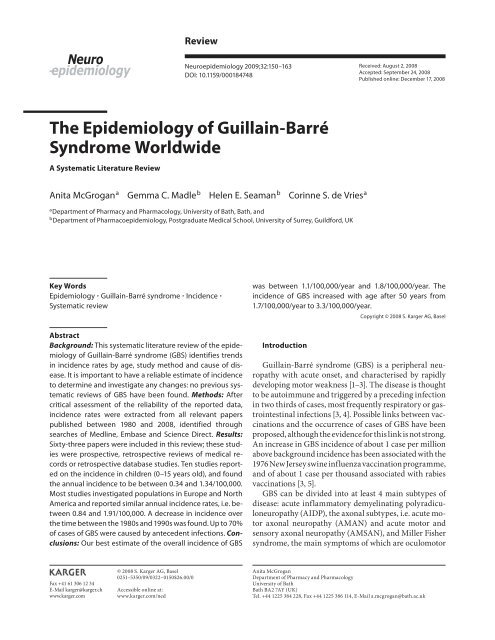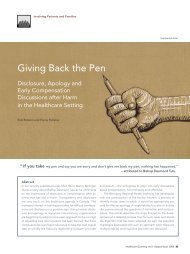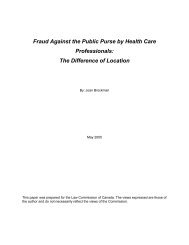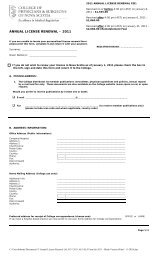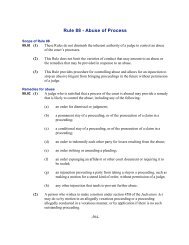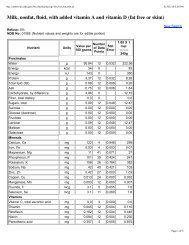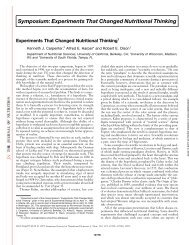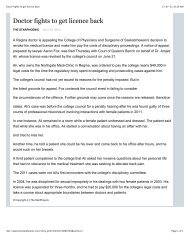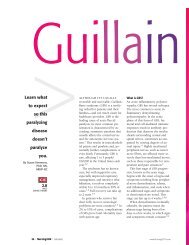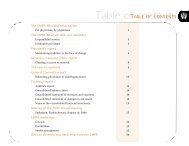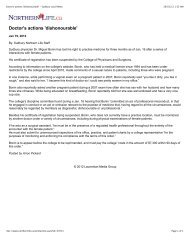The Epidemiology of Guillain Barre Syndrome Worldwide - TUUM EST
The Epidemiology of Guillain Barre Syndrome Worldwide - TUUM EST
The Epidemiology of Guillain Barre Syndrome Worldwide - TUUM EST
Create successful ePaper yourself
Turn your PDF publications into a flip-book with our unique Google optimized e-Paper software.
ReviewNeuroepidemiology 2009;32:150–163DOI: 10.1159/000184748Received: August 2, 2008Accepted: September 24, 2008Published online: December 17, 2008<strong>The</strong> <strong>Epidemiology</strong> <strong>of</strong> <strong>Guillain</strong>-Barré<strong>Syndrome</strong> <strong>Worldwide</strong>A Systematic Literature ReviewAnita McGrogan a Gemma C. Madle b Helen E. Seaman b Corinne S. de Vries aaDepartment <strong>of</strong> Pharmacy and Pharmacology, University <strong>of</strong> Bath, Bath , andbDepartment <strong>of</strong> Pharmacoepidemiology, Postgraduate Medical School, University <strong>of</strong> Surrey, Guildford , UKKey Words<strong>Epidemiology</strong> <strong>Guillain</strong>-Barré syndrome Incidence Systematic reviewAbstractBackground: This systematic literature review <strong>of</strong> the epidemiology<strong>of</strong> <strong>Guillain</strong>-Barré syndrome (GBS) identifies trendsin incidence rates by age, study method and cause <strong>of</strong> disease.It is important to have a reliable estimate <strong>of</strong> incidenceto determine and investigate any changes: no previous systematicreviews <strong>of</strong> GBS have been found. Methods: Aftercritical assessment <strong>of</strong> the reliability <strong>of</strong> the reported data,incidence rates were extracted from all relevant paperspublished between 1980 and 2008, identified throughsearches <strong>of</strong> Medline, Embase and Science Direct. Results:Sixty-three papers were included in this review; these studieswere prospective, retrospective reviews <strong>of</strong> medical recordsor retrospective database studies. Ten studies reportedon the incidence in children (0–15 years old), and foundthe annual incidence to be between 0.34 and 1.34/100,000.Most studies investigated populations in Europe and NorthAmerica and reported similar annual incidence rates, i.e. between0.84 and 1.91/100,000. A decrease in incidence overthe time between the 1980s and 1990s was found. Up to 70%<strong>of</strong> cases <strong>of</strong> GBS were caused by antecedent infections. Conclusions:Our best estimate <strong>of</strong> the overall incidence <strong>of</strong> GBSwas between 1.1/100,000/year and 1.8/100,000/year. <strong>The</strong>incidence <strong>of</strong> GBS increased with age after 50 years from1.7/100,000/year to 3.3/100,000/year.IntroductionCopyright © 2008 S. Karger AG, Basel<strong>Guillain</strong>-Barré syndrome (GBS) is a peripheral neuropathywith acute onset, and characterised by rapidlydeveloping motor weakness [1–3] . <strong>The</strong> disease is thoughtto be autoimmune and triggered by a preceding infectionin two thirds <strong>of</strong> cases, most frequently respiratory or gastrointestinalinfections [3, 4] . Possible links between vaccinationsand the occurrence <strong>of</strong> cases <strong>of</strong> GBS have beenproposed, although the evidence for this link is not strong.An increase in GBS incidence <strong>of</strong> about 1 case per millionabove background incidence has been associated with the1976 New Jersey swine influenza vaccination programme,and <strong>of</strong> about 1 case per thousand associated with rabiesvaccinations [3, 5] .GBS can be divided into at least 4 main subtypes <strong>of</strong>disease: acute inflammatory demyelinating polyradiculoneuropathy(AIDP), the axonal subtypes, i.e. acute motoraxonal neuropathy (AMAN) and acute motor andsensory axonal neuropathy (AMSAN), and Miller Fishersyndrome, the main symptoms <strong>of</strong> which are oculomotorFax +41 61 306 12 34E-Mail karger@karger.chwww.karger.com© 2008 S. Karger AG, Basel0251–5350/09/0322–0150$26.00/0Accessible online at:www.karger.com/nedAnita McGroganDepartment <strong>of</strong> Pharmacy and PharmacologyUniversity <strong>of</strong> BathBath BA2 7AY (UK)Tel. +44 1225 384 228, Fax +44 1225 386 114, E-Mail a.mcgrogan@bath.ac.uk
dysfunction, ataxia and areflexia. In North America andEurope, around 5% <strong>of</strong> patients with GBS have the axonalsubtypes, whereas in Central and South America, Japanand China axonal subtypes account for 30–47% <strong>of</strong> cases[5] ; Miller-Fisher syndrome has been found to accountfor around 5% <strong>of</strong> cases <strong>of</strong> GBS [3, 5] . Standard criteria forthe diagnosis <strong>of</strong> GBS were published in 1978 by a NationalInstitute <strong>of</strong> Neurological and Communicative Diseases(NINCDS) committee. <strong>The</strong> criteria include clinical featuressuch as progression, relative symmetry and mildsensory symptoms or signs as well as levels <strong>of</strong> protein incerebrospinal fluid, and electrodiagnostic features, suchas nerve conduction slowing or blocking [2] . Typicaltreatment regimens for GBS include plasma exchangeand intravenous immunoglobulin. Both treatments arethought to be equally efficacious, but Tsai et al. [6] showedthat intravenous immunoglobulin may be cheaper due topatients having fewer complications and requiring ashorter stay in hospital; direct health care costs were estimatedto be approximately USD 110,000 in the USA.Insight into the incidence <strong>of</strong> disease is important forthe identification <strong>of</strong> trends in relation to patient characteristics,such as age and geographical location, and todetermine any changes in incidence following exposureto new environmental factors. Previous reviews evaluatingthe incidence <strong>of</strong> GBS have found rates to be between0.16 and 4.0/100,000/year in individuals <strong>of</strong> all ages [3, 4]and between 0.5 and 1.5/100,000/year in those under 18years [7] . <strong>The</strong> highest rates have been reported in adults,especially those aged over 75 years [4, 5] . Unusually foran autoimmune disease, higher incidence rates have beenreported in males than females [4] .To our knowledge, no systematic evaluation <strong>of</strong> publishedstudies <strong>of</strong> the incidence <strong>of</strong> GBS has been published.Previous epidemiological reviews <strong>of</strong> GBS include: Sladky[7] who reported on incidence <strong>of</strong> GBS in children, Govoniand Granieri [3] who included studies published between1978 and 2000 and described overall trends in incidencerates, and Hughes and Rees [4] who tabulatedrates from 35 studies published between 1958 and 1996.<strong>The</strong> objectives <strong>of</strong> this literature review were to identifyreliable estimates <strong>of</strong> GBS incidence, to compare rates byage and geography, and to examine any changes in incidenceover time.MethodSearches <strong>of</strong> the Medline (1980–2008), EMBASE (1980–2008)and Science Direct (1980–2008) databases were carried out usingthe keywords ‘<strong>Guillain</strong>-Barré <strong>Syndrome</strong>’ or ‘polyradiculoneuropathy’and ‘incidence’ or ‘epidemiology’. <strong>The</strong> 2 disease terms wereused because the MeSH term ‘<strong>Guillain</strong>-Barré syndrome’ was onlyused in Medline from 1998.<strong>The</strong> inclusion criteria were that the studies reported originalwork, that a reasonable effort had been made by the authors to includeall incident cases and that the estimates <strong>of</strong> population sizeand person-time contributed during the study period were accurate.When assessing the likelihood <strong>of</strong> missing incident cases, paperswere evaluated as follows: (1) for case-finding studies, did theauthors ensure that all <strong>of</strong> the subjects contributing person-time tothe denominator data were available as potential cases and did theauthors check all relevant medical records? (2) for all studies, werecases checked to ensure that they were incident and not prevalent?(3) for all studies, did the authors ensure that the cause <strong>of</strong> GBS wasautoimmune and it was not secondary to another disease?<strong>The</strong> titles and abstracts (where available) <strong>of</strong> all <strong>of</strong> the studiesidentified by the searches were reviewed by 2 investigators. Studiespublished in English, French, German, Spanish or Dutch wereincluded. <strong>The</strong> full text <strong>of</strong> all potentially relevant papers was appraisedand decisions about inclusion <strong>of</strong> papers were discussed byall authors. Review papers were searched for secondary referencesreporting on original research; secondary references foundfrom any <strong>of</strong> the other papers reviewed were also included.A standard data abstraction form was used to record all details<strong>of</strong> the papers reviewed (appendix 1). Each study was classified asbeing at low, medium or high risk <strong>of</strong> under- or overestimation <strong>of</strong>reported incidence rates by considering the reliability <strong>of</strong> numeratorand denominator data. For instance, inclusion <strong>of</strong> prevalent cases orthose thought not to be caused by autoimmunity will have led tooverestimated rates, as will underestimated denominator data.Conversely, missing cases or an overestimated denominator (e.g. acatchment area from which not all inhabitants had access to hospitalservices) would be considered to result in underestimated incidencerates. Explanations provided by the papers’ authors as to whyincidence rates were as expected or whether they were consideredto be an over- or underestimate <strong>of</strong> the true incidence rate were takeninto account in this process. If the extent <strong>of</strong> likely error was consideredto be very great, the study was excluded. To minimise subjectivity,this assessment was agreed between the authors and randomchecks were performed to ensure consistency. Rates arepresented as the number <strong>of</strong> cases/100,000/year and where sufficientdata were given in the paper, rates were checked for accuracy.ResultsFigure 1 shows the results <strong>of</strong> the database searches andsubsequent filtering <strong>of</strong> search results. A list <strong>of</strong> all <strong>of</strong> thereferences considered for this study but excluded is availableon request from the authors.Of the 457 papers rejected at the abstract review stage,nearly half did not focus on GBS as the subject <strong>of</strong> the paperand one fifth did not investigate incidence <strong>of</strong> GBS;other key reasons for rejecting papers at this stage includedthose reviewing the disease, case series, those investigatingoutcomes <strong>of</strong> vaccinations and those reporting onincidence <strong>of</strong> a disease other than GBS. Following reviewIncidence <strong>of</strong> GBS Neuroepidemiology 2009;32:150–163 151
457 papers rejected after abstractreview511 papers identified in databasesearchColor version available online54 full papers appraised40 secondary papers appraised31 papers rejected63 full papers included in reviewFig. 1. Results from Medline search.<strong>of</strong> the full papers, 31 papers were rejected; key reasons forthis included papers that reviewed the disease and did notprovide primary data on incidence, papers reporting datagiven in other papers already included, incidence ratesnot presented and too few data given to calculate incidencerates and papers reporting incidence data thoughtto be very unreliable. Each <strong>of</strong> the 63 studies included inthis review is described in table 1 , first for children andthen for adults grouped by continent. Incidence rates brokendown by age band are given in table 2 .Incidence Rates<strong>The</strong> incidence rates found for GBS varied between0.38/100,000/year (95% CI 0.25–0.56) in Finland [8] and2.53/100,000/year (95% CI 1.87–3.35) in Curaçao [9] ( table1 ).Geographical VariationMost <strong>of</strong> the studies included in this review were fromEurope and North America where the majority <strong>of</strong> incidencerates were between 0.84/100,000/year (Finland) [10]and 1.91/100,000/year (Italy) [11] . For other parts <strong>of</strong> theworld, very few studies were found, and therefore it is difficultto comment on any geographical trends. For the datapresented, a comparison <strong>of</strong> these rates with those <strong>of</strong> Europeand North America suggest that incidence was lower inChina [12, 13] , Hong Kong [14] and Brazil [15] , similar inTanzania [21] , Australia [16, 17] and Japan [18] and slightlyhigher in the Middle East [19, 20] and Curaçao [9] .Variation over TimeMost studies covered time periods between 1980 and2000 [9–19, 21–43] . Between 1980 and 2000, the incidencewas between 1.0/100,000/year and 1.8/100,000/year. Only 3 studies reported rates from 2000 onwards,and these were thought to be unreliable [20, 44, 45] .Variation with AgeIn the majority <strong>of</strong> studies that included incidence ratesbroken down by age, increases in rates were observed inmost studies <strong>of</strong> people aged 50 years or more [11, 17, 22,26, 31–33, 35–39, 46–49] , with some showing a decreasein the highest age group <strong>of</strong> 6 80 years [22, 26, 31, 35–38,47–49] .Overall incidence rates in children ranged from0.34/100,000/year to 1.34/100,000/year [31, 34] . In thestudies that investigated incidence in children (0–9 years)and teenagers (10–19 years), most showed an increase inincidence with increasing age [19, 37, 38, 48–51] , althoughsome demonstrated decreases [12, 13, 17, 46, 47] .152Neuroepidemiology 2009;32:150–163McGrogan /Madle /Seaman /de Vries
Table 1. Description <strong>of</strong> studies and overall incidence by continentStudy Location Study method DiagnosticcriteriaCasesnAntecedentinfection, %Period Age Rate100,000/yearChildrenHung et al. [60]RUE: **ROE: *Rantala et al. [8]RUE: *ROE: *Artan [61]RUE: *ROE: *Barzegar et al. [53]RUE: **ROE: *Ismail et al. [67]RUE: **ROE: *Molinero et al. [57]RUE: **ROE: ***Rantala et al. [68]RUE: *ROE: *Olive et al. [58]RUE: *ROE: **Dias-Tosta et al. [54]RUE: *ROE: **Hart et al. [59]RUE: *ROE: *TaiwanFinlandAntalya,TurkeyEasternAzerbaijan,IranKuwaitmedical record review by paediatricneurologistshospital discharge database; diagnoses<strong>of</strong> cases reviewedretrospective study <strong>of</strong> cases <strong>of</strong> acuteparalysis reported to Ministry <strong>of</strong> Healthsystematic registration <strong>of</strong> children withacute flaccid paralysis; all cases referred.retrospective review <strong>of</strong> medical recordsidentifying hospital discharges codedfor GBS; records reviewedNINCDS 72 all: 83URI: 68GI: 7other: 7not given 27 all: 85URI: 67Asbury andCornblathAsbury andCornblathAsbury andCornblathHonduras prospective hospital-based study Asbury andCornblathLos Angelesand OrangeCounties,USASouthAmericaBrazilParaguaymedical records <strong>of</strong> those dischargedfrom children’s hospitals; case historiesreviewed by paediatric neurologistall cases <strong>of</strong> acute flaccid paralysis mustbe reported for surveillance; activesearches: door to door survey, hospitaladmissions, death certificates; moredetailed studies in 7 countriescases identified from the FundaçãoNacional de Saúde <strong>of</strong> the Brazilian Ministry<strong>of</strong> Health; data collected during apoliomyelitis surveillance programmereviewed and 60-day follow-upcompulsory reporting <strong>of</strong> GBS cases tothe Ministry <strong>of</strong> Health; cases also identifiedthrough door-to-door vaccinationprograms and a notification agreementwith neighbouring countries; recordsreviewedreview <strong>of</strong> caseswith ICD356.0–357.91986–90 0–16 0.661980–86 ≤15 0.38(0.25–0.56) 111 URI: 63 1990–96 1–14 0.54143 all: 69URI: 52GI: 14other: 319 all: 79URI: 682001–06 0–15 2.271992–97 ≤12 0.95(0.52–1.37) 1, 2GI: 11394 not given 1989–99
Table 1 (continued)Study Location Study method DiagnosticcriteriaCasesnAntecedentinfection, %Period Age Rate100,000/yearAustralasiaStorey et al. [16]RUE: **ROE: *Hankey [17]RUE: **ROE: *Victoria,AustraliaWesternAustraliamedical record systems in teachinghospitals; all cases reviewedcase record search for GBS, polyneuritisor polyneuropathy codescriteria notgiven110 URI: 34GI: 121980–84 ≥15 0.90 3Asbury 109 all: 58 1980–85 all 1.35(1.10–1.61) 1, 2<strong>The</strong> Caribbeanvan Koningsveld et al. [9]RUE: *ROE: *Curaçaomedical records with relevant ICD-9codes; cases reviewedNINCDS 49 all: 92URI: 5influenza: 25GI: 55other: 71987–96 all 2.53(1.87–3.35) 1EuropeBak [62]RUE: *ROE: **Halls et al. [63]RUE: **ROE: **Hughes et al. [22]RUE: *ROE: *MacDonald et al. [23]RUE: *ROE: **Haberman et al. [64]RUE: **ROE: *Winner et al. [46]RUE: *ROE: *Rees et al. [24]RUE: **ROE: *Kinnunen et al. [10]RUE: *ROE: **Lehmann [44]RUE: **ROE: ***Markoula et al. [25]RUE: **ROE: *Chroni et al. [26]RUE: *ROE: *Anon [27, 47]RUE: *ROE: *Paolino et al. [28]RUE: *ROE: *RingkobingCounty,DenmarkCopenhagencounty,DenmarkUKLondon,EnglandNorth-WestThames,EnglandOxfordshire,Englandsouth-eastEnglandFinlandGermanynorth-westGreecesouth-westGreeceEmilia-Romagna,ItalyFerrara,Italyrecord review for patients admitted toall hospitals in the county.record review <strong>of</strong> those with a diagnosis<strong>of</strong> neuropathy, to find cases <strong>of</strong> GBSpopulation-based study using GeneralPractice Research databasecase ascertainment using referrals,databases, clinic records and patientmedical recordsretrospective review <strong>of</strong> hospital activityanalysishospital records and those from recordlinkage study used with discharge codesfor GBS or acute infective polyneuritis(ICD-8 354, ICD-9 357.0, 357.9)prospective reporting <strong>of</strong> cases, hospitalactivity analysis, research database anddeath certificatescases with diagnosis <strong>of</strong> polyradiculitisfound from hospital discharge databaseand reviewed by a neurologistnationwide administrative databasefrom reimbursement scheme implementationrecords <strong>of</strong> patients admitted to neurologyinpatients reviewed; variants wereincludedretrospective review <strong>of</strong> medical records;many cases followed up after 14months.prospective study <strong>of</strong> all neurologicalunits and relevant departments;discharges using ICD codes were alsocheckedmedical records from relevant departmentssearched; diagnosis <strong>of</strong> GBS andrelated disorders checkedDanish ICDcode for GBS(ICD adaptation)criteria notgivencodes for GBSor infectiveneuritis useddiagnosticcriteria notgivenICD-8 code354.9, clinical features,diagnosedby a neurologistNINCDS, MFalso included(Asbury)Asbury andCornblathcriteria usedAsbury andPoser criteriausedICD-10 codeG61.0 used t<strong>of</strong>ind cases51 all: 41 1965–82 all 1.14 334 not given 1977–84 all 1.50(0.90–2.30) 3228 not given 1992–2000 all 1.33(1.15–1.50) 1, 3notgivennot given 1995–96 all 3.0(1.0–6.0) 1, 439 not given 1978 all 1.10(0.77–1.48) 172 not given 1978 all 1.10(0.80–1.40) 179 not given 1993–94 all 1.20(0.90–1.40) 1247 all: 67 1981–86 all 0.84(0.56–1.25) 14,349 not given 2003 all 1.78 22004 1.6 22005 1.89 2NINCDS 46 all: 61URI: 30GI: 26NINCDS 105 all: 50URI: 29GI: 7other: 14not given 105 all: 70URI: 46influenza: 13GI: 11NINCDS 16 all: 38URI: 19GI: 6other: 131996–2005 all 1.221989–2001 all 0.99(0.81–1.19) 11992–93 allNINCDS 1.11(0.89–1.36) 1GBS and1.2variants(0.96 1.46) 1, 31981–87 all 1.26(0.65–1.88) 1, 2154Neuroepidemiology 2009;32:150–163McGrogan /Madle /Seaman /de Vries
Table 1 (continued)Study Location Study method DiagnosticcriteriaCasesnAntecedentinfection, %Period Age Rate100,000/yearGovoni et al. [11, 29]RUE: *ROE: *Beghi et al. [30]RUE: *ROE: *Bogliun et al. [31]RUE: **ROE: *D’Ambrosio et al. [52]RUE: ***ROE: *Chio et al. [32]RUE: *ROE: *Congia et al. [55]RUE: ***ROE: *van Koningsveldet al. [33]RUE: *ROE: *Larson et al. [56]RUE: *ROE: *Sridharan et al. [34]RUE: *ROE: *Cuadrado et al. [35]RUE: *ROE: *Cuadrado et al. [36]RUE: *ROE: *Sedano et al. [50]RUE: *ROE: **Jiang et al. [37]RUE: *ROE: **Cheng et al. [38]RUE: *ROE: *Jiang et al. [48]RUE: *ROE: *Jiang et al. [49]RUE: *ROE: *Ferrara,ItalyLombardy,ItalyLombardy,ItalyNaples andprovince,ItalyPiedmont andValle d’Aosta,ItalySardinia,Italysouth-westNetherlandswesternNorwayGrampian,Orkney andShetland,ScotlandSpainSpainCantabria,SpainSwedenSwedenStockholmCounty,Swedensouth-westStockholm,Swedenprospective identification <strong>of</strong> patientsreferred to neurological wards; retrospectivereview <strong>of</strong> medical records anddischarge records (ICD-9 356.9, 357.0,356.4, 356.8)prospective hospital-based survey;patients were interviewed and atypicalcases discussedcases traced through hospital, prospectiveregional registry started in 1994;hospital discharges also checked forICD-9 code 357.0admission diagnoses reviewed andrecords examinedprospective recording in registry <strong>of</strong>cases found in neurology departments;hospital discharge databases alsochecked for ICD-9 codes 357.0, 357.8and 357.9; cases verifiedretrospective review <strong>of</strong> medical recordsand hospitalisationsretrospective review <strong>of</strong> medical recordschecking for ICD-9 codes 357.0, 357.8and 357.9; cases re-evaluated by neurologistNINCDS (GBS);Asbury andCornblath(variants)NINCDS (GBS);Ropper (variants)NINCDS (GBS);Asbury and Ropper(variants)43 [29],26 [11]all: 54URI: 23GI: 9other: 221981–93[29], 1994–2001 [11]all 1.66 31.91(1.49–2.43)109 not given 1994–95 all 0.92(0.75–1.09) 1138 all: 30URI: 13GI: 71993–96 all 1.43(1.16–1.74) 1influenza: 10NINCDS 46 not given 1971–80 all 0.16(0.11–0.21) 1, 2NINCDS 120 all: 58URI/influenza:41GI: 14other: 41995–96 all 1.28(1.04–1.51) 5NINCDS 120 all: 36 1961–80 all 0.40(0.33–0.47) 1, 2NINCDS 476 all: 79URI: 22GI: 20influenza: 25other: 121987–96 1.14(1.04–1.24) 3hospital records searched for cases NINCDS 109 all: 57 1957–82 all 1.19 3retrospective search <strong>of</strong> hospital recordsand morbidity records using ICD-8 354,ICD-9 357.0 and 357.9 codes; diagnosisconfirmed by neurologistretrospective review <strong>of</strong> hospital records,laboratory records and discharge filesprospective population-based studywith cases reported to central units;records <strong>of</strong> cases checked by neurologisthospital medical records searched forICD-8 code 354cases discharged from a first hospitalstayprospective data collection <strong>of</strong> newlyreported cases identified by neurologists;inpatient registries checked forthose with ICD-9 code 357Amedical records searched forappropriate ICD codesNINCDS 36 influenza: 42 1980–88 all 1.1(0.8–1.4) 1NINCDS 337 URI: 31GI: 12NINCDS 98 all: 62URI: 43GI: 10other: 9NINCDS 69 all: 36URI: 23GI: 9ICD-9 code357A1985–97 >19 0.86 31998–99 >19 1.26 31975–88 all 0.95(0.73–1.18) 2 3other: 42,257 not given 1978–93 all 1.77 3, 6NINCDS 73 not given 1996 all 1.51(1.18–1.90) 3codes ICD-8354.01 ICD-9357A556 not given 1973–91 all 1.89(1.72–2.03) 1, 2as above as above 84 not given 1973–91 all 1.56(1.24 1.93) 3Incidence <strong>of</strong> GBS Neuroepidemiology 2009;32:150–163 155
Table 1 (continued)Study Location Study method DiagnosticcriteriaCasesnAntecedentinfection, %Period Age Rate100,000/year<strong>The</strong> Middle EastArami et al. [20]RUE: **ROE: *Radhakrishnan et al. [19]RUE: *ROE: **Eastern Azerbaijan,IranBenghazi,Libyaprospective survey <strong>of</strong> all new cases <strong>of</strong>GBS admitted to 3 referral centresscreening through clinics, hospitals andother centres identified casesNINCDS 76 all: 65.8URI: 50GI: 162003 all 2.11(1.64–2.59) 2, 3not given 27 all: 26 1983–85 all 1.73 3North America and CanadaHauck et al. [39]RUE: **ROE: **McLean et al. [40]RUE: *ROE: *Alshekhlee et al. [45]RUE: **ROE: ***Kaplan et al. [65]RUE: *ROE: *Church Potter et al. [41]RUE: *ROE: ***Beghi et al. [66]RUE: *ROE: *Hoppock et al. [42]RUE: *ROE: **Koobatian et al. [43]RUE: *ROE: *Riggs et al. [51]RUE: **ROE: *Alberta,CanadaQuebec andOntario,CanadaUSAColorado,USAMichigan,USAOlmstedcounty,USASedgwickCounty,Kansas,USAVermont,USAWest Virginia,USAadministrative sources maintained bythe Ministry <strong>of</strong> Health and Wellness <strong>of</strong>the Government <strong>of</strong> Albertahospital discharge databases searched;sample <strong>of</strong> cases checked by 2 neurologistsidentified cohort from the NationwideInpatient Sample which records datafrom approx. 20% <strong>of</strong> community hospitalsretrospective review <strong>of</strong> medical recordsdata on GBS cases collected retrospectivelyfrom the community healthreportable disease database and GBSregistryretrospective review <strong>of</strong> medical records<strong>of</strong> the Mayo Clinic record-linkage system;records evaluated and diagnosisconfirmed by neurologistscodes used t<strong>of</strong>ind casesICD-9 codes357.0, 357.8,357.9 and 375.0included: ICD-9codes for GBS(357.0); excluded:357.81, 357.82,359.81, 357.4,045, 045.1, 358.0,358.01, 358.1,358.8, 323, 303.0,960, 979diagnosed by aneurologist;records withICD-9 357.0revieweddiagnosticcriteria notgivencodes identifiedincluded GBS,polyradiculitis,peripheral neuritisor neuronitishospital records were reviewed ICD code 357.0and clinical featurescomputer discharge abstracts from allhospitals searched for GBS ICD-9 code357.0medical records <strong>of</strong> patients admittedwith acute neuropathies reviewed496 not given 1994–04 all 1.142,333 not given 1983–89 allOntario 1.51Quebec 1.784,956 not given 2000–04 >17 1.72 248 all (Larimer 1975–83 allCounty): 86URI 53LarimerCounty2.20(1.41–3.02) 1, 2GI 23other 10WeldCounty1.80(0.97–2.55) 1, 2471 not given 1992–99 0.6348 all 65 1935–80 all 1.77 343 all: 73URI: 47GI: 21URI and GI: 51984–88 all 2.2NINCDS 51 all: 57 1980–85 1.6not given 92 not given 1967–87 all 1.7 3South AmericaRocha et al. [15]RUE: ***ROE: *Sao Paulo,Brazilmedical record review (1995–1999)and clinical registration <strong>of</strong> cases(2000–2002); all cases examined byneurological staffAsbury andCornblath95 all: 58URI: 46GI: 121995–2002 all 0.40(0.32–0.48) 1, 2Figures in parentheses are 95% CI.RUE = Risk <strong>of</strong> underestimation; ROE = risk <strong>of</strong> overestimation; * = low; ** = medium; *** = high; MF = Miller-Fisher; URI = upper respiratory tractinfection; GI = gastrointestinal infection.1Rate checked and confirmed. 2 CI added. 3 Standardised rate. 4 Date used in incidence calculations is date <strong>of</strong> diagnosis. 5 Rate calculated from number<strong>of</strong> cases and population data provided in the paper. 6 Date used in incidence calculations is date <strong>of</strong> first admission to hospital.156Neuroepidemiology 2009;32:150–163McGrogan /Madle /Seaman /de Vries
Clinical Variants <strong>of</strong> GBSVery few studies included in this review gave informationabout incidence <strong>of</strong> the clinical variants <strong>of</strong> GBS – <strong>of</strong>those studies that did, the main variant <strong>of</strong> GBS, Miller-Fisher syndrome, was much less common than GBS. Ifcases <strong>of</strong> these diseases were included in any studies <strong>of</strong>GBS incidence, then the overall incidence rate would onlybe overestimated by a small amount.Antecedent InfectionA number <strong>of</strong> the studies included in this review gavedetails <strong>of</strong> numbers <strong>of</strong> cases reporting an antecedent infection,usually less than 4 weeks, before onset <strong>of</strong> GBS. <strong>The</strong>sedata have been recorded in table 1 along with a breakdown<strong>of</strong> the type <strong>of</strong> infection, where given. In most studiesreporting this information, 40–70% <strong>of</strong> cases recordedan infection before onset with 22–53% having an upperrespiratory tract infection and 6–26% a gastrointestinalinfection. Children’s rates were higher, with 67–85% <strong>of</strong> allcases reporting an infection: 50–70% were respiratory infectionsand 7–14% gastrointestinal infections.Seasonal Variation<strong>The</strong> issue <strong>of</strong> seasonal variation in incidence was raisedin some studies although none reported significant differencesin levels <strong>of</strong> onset <strong>of</strong> GBS between seasons [16, 28,29, 50, 52–54] . Some found more cases in colder months[9, 19, 20, 46, 55, 56] although a cluster <strong>of</strong> cases was reportedin spring and summer in Brazil [15] , during thewinter and June in the Netherlands [33] and during autumnin Sweden [37] .Study MethodStudy design is an important consideration when comparingincidence rates between different studies. In thisreview, the studies included were <strong>of</strong> 3 types: prospective[11–13, 20, 24, 27, 29–32, 36, 38, 47, 53, 54, 57–59] , retrospectivemedical record review [9, 14–19, 21, 25, 26, 33–35, 41, 46, 50–52, 55, 56, 60–66] and retrospective databasestudies with [8, 10, 40, 67, 68] or without [22, 23, 37,39, 42–45, 48, 49] the review <strong>of</strong> cases by a clinician. Atfirst glance, it would appear that study design did nothave a sizeable effect as the incidence rates found weresimilar. However, when incidence rates were comparedby type <strong>of</strong> study, some trends became apparent. For theprospective studies, the majority <strong>of</strong> incidence rates werebetween 1.11/100,000/year and 1.66/100,000/year; for theretrospective record review studies and the databasestudies with record review, most were between 0.83/100,000/year and 1.77/100,000/year and for the databasestudies where a review <strong>of</strong> cases was not performed, 1.14/100,000/year to 2.2/100,000/year. Prospective studies areusually the most reliable; using this as the standard suggeststhat some <strong>of</strong> the database studies overestimated incidencerate and some <strong>of</strong> the retrospective record reviewstudies underestimated rates.Most patients diagnosed with GBS will be hospitaliseddue to the nature <strong>of</strong> the disease [8, 26, 32, 33, 35–37, 64] :3 studies reported small numbers <strong>of</strong> outpatient or communitypatients identified in their studies compared withnumbers <strong>of</strong> hospitalised GBS cases [12, 32, 38] . Ten studiesnoted the inclusion <strong>of</strong> mild cases in their studies [16,24, 29, 33, 38, 45, 46, 50, 57, 59] and the design <strong>of</strong> otherstudies implied the inclusion <strong>of</strong> mild cases: 2 studies usinggeneral practitioner records [22, 23] , a surveillancestudy [54] , a door-to-door survey [58] and the recordlinkage system used by the Mayo Clinic [66] . Of thosestudies that used mainly hospital records, 2 noted that allpatients were given intravenous immunoglobulin or plasmaexchange therapy [20, 67] , and this implies that onlyserious cases were included, whereas others reported proportions<strong>of</strong> patients receiving these therapies <strong>of</strong> between24 and 49% for intravenous immunoglobulin and 34–51% receiving plasma exchange [26, 27, 30, 47, 61] . Tenstudies reported missing mild cases [12, 32, 36, 64, 69, 70]or reported finding it difficult to detect mild cases if theyhad not been admitted to hospital [17, 25, 37, 62] .DiscussionMost <strong>of</strong> the incidence rates <strong>of</strong> GBS reported were between1.1/100,000/year and 1.8/100,000/year with lowerrates reported in children ( ! 16 years) <strong>of</strong> 0.4/100,000/yearto 1.4/100,000/year. Most <strong>of</strong> the studies included werefrom Europe and North America where the rates foundwere similar.A number <strong>of</strong> studies have commented on a bimodalpattern <strong>of</strong> incidence by age, with peaks occurring inyoung adults and the elderly [3, 24, 71] . In this review,only 1 study [19] (out <strong>of</strong> 24) found a peak in incidence inyoung adults, although the rates were not adjusted and ahigh proportion <strong>of</strong> young adults in this area could havebiased the incidence rates found.<strong>The</strong> majority <strong>of</strong> studies used the recognised NINCDScriteria or a comparable set <strong>of</strong> diagnostic criteria, and thisallowed comparisons to be made between studies. Oneimportant difference between studies that should behighlighted is the study method used. In this review, theoverall incidence rates found by the prospective studiesIncidence <strong>of</strong> GBS Neuroepidemiology 2009;32:150–163 157
Table 2. Incidence <strong>of</strong> GBS by age band (only those studies that gave incidence by age band are included in the table)Study Sex Age bands and incidence rates/Chroniet al. [26]0–5 6–9 10–14 15–19 20–24 25–29 30–34 35–39 40–44 45–49 50–54 55–59 60–64 65–69 70–74 75–79 80–84 85+both 0.83 1, 2 1.17 1, 2 0.67 1, 2 0.42 1, 2 0.58 1, 2 0.67 1, 2 0.42 1, 2 0.75 1, 2 0.83 1, 2 1.33 1, 2 0.67 1, 2 3.33 1, 2 0.5 1, 2 2 1, 2 2.17 1, 2 2.67 1, 2 1.83 1, 2 0 1, 2vanKoningsveldet al. [33]0–4 5–9 10–14 15–19 20–24 25–29 30–34 35–39 40–44 45–49 50–54 55–59 60–64 65–69 70–74 75–79 80–84both 0.58 2, 3 0.74 2, 3 0.22 2, 3 0.66 2, 3 0.74 2, 3 0.99 2, 3 0.97 2, 3 0.92 2, 3 0.92 2, 3 1.08 2, 3 1.14 2, 3 1.47 2, 3 1.42 2, 3 1.99 2, 3 2.2 2, 3 1.82 2, 3 1.91 2, 3Jianget al. [37]0–4 5–9 10–14 15–19 20–24 25–29 30–34 35–39 40–44 45–49 50–54 55–59 60–64 65–69 70–74 75–79 80+both 0.61 2, 4 0.79 2, 4 0.85 2, 4 1.33 2, 4 1.58 2, 4 1.45 2, 4 1.45 2, 4 1.27 2, 4 1.58 2, 4 1.45 2, 4 2.48 2, 4 2.55 2, 4 3.09 2, 4 3.64 2, 4 4.24 2, 4 3.64 2, 4 2.42 2, 4Hugheset al. [22]0–14 15–24 25–34 35–44 45–54 55–64 65–74 75–84 85–100male 0.47female 0.42(0.19–0.96) 5, 6 0.63(0.23–1.38) 5, 6 0.87(0.43–1.56) 5, 6 1(0.52–1.75) 5, 6 1.98(1.24–3.00) 5, 6 3.15(2.05–4.61) 5, 6 3.86(2.5–5.7) 5, 6 2.85(1.37–5.25) 5, 6 2.26(0.27–8.14) 5, 6(0.15–0.92) 5, 6 (0.52–1.98) 5, 6 (0.61–1.86) 5, 6 (0.72–2.13) 5, 6 (0.64–2.06) 5, 6 (1.39–3.23) 5, 6 (1.02–3.13) 5, 6 (1.39–4.27) 5, 6 (0.10–3.11) 5, 61.081.111.291.212.31.862.540.86Winner andEvans [46]0–4 5–14 15–24 25–34 35–44 45–54 55–64 65–74 75+both 1.30 0.10 0.70 1.20 1.00 1.50 2.00 1.80 1.90Habermanet al. [64]0–4 5–14 15–44 45–64 65–74 75+both 0.50(0.00–1.30 5, 6 (0.00–1.30) 5, 6 (0.60–2.20) 5, 6 (0.40–3.40) 5, 6 (0.00–2.6) 5, 60.601.10 (0.60–1.60) 5, 6 1.401.901.1Hankey [17] 0–9 10–19 20–29 30–39 40–49 50–59 60–69 70–79 80–90both 1.13(0.56–1.72) 5, 6 (0.22–1.03) 5, 6 (0.95–2.27) 5, 6 (0.69–1.95) 5, 6 (0.14–1.24) 5, 6 (1.02–3.12) 5, 6 (1.24–3.97) 5, 6 (0.36–3.20) 5, 6 (0.07–6.55) 5, 60.621.611.320.682.072.61.773.30Chenget al. [12]0–9 10–19 20–29 30–39 40–49 50–59 60+both 1.15(0.44–1.86) 5, 6 (0.19–1.29) 5, 6 (0.16–1.06) 5, 6 (0.01–0.79) 5, 6 (0.01–1.48) 5, 6 (0.00–1.06) 5, 6 (0.00–1.20) 5, 60.740.610.40.750.440.50Zhanget al. [13]0–9 10–19 20–29 30–39 40–49 50–59 60+both 0.89 2 0.74 2 0.49 2 0.67 2 0.85 2 0.60 2 0.48 2Kusumiet al. [18]0–9 10–19 20–29 30–39 40–49 50–59 60–69 70+male 2.62 2, 3 2.30 2, 3 9.84 2, 3 7.70 2, 3 6.39 2, 3 2.62 2, 3 5.57 2, 3 3.77 2, 3female 0.00 2, 3 2.30 2, 3 6.23 2, 3 2.62 2, 3 8.85 2, 3 9.84 2, 3 11.64 2, 3 6.56 2, 3Anon [47] 0–9 10–19 20–29 30–39 40–49 50–59 60–69 70+both 0.730.36(0.01–1.44) 5,6(0–0.77) 5, 6 (0.38–1.5) 5, 6 (0.29–1.38) 5, 6 (0.36–1.52) 5, 6 (0.62–1.98) 5, 6 (1.41–3.28) 5, 6 (1.02–2.69) 5, 60.940.830.941.302.341.85Paolinoet al. [28]0–9 10–19 20–29 30–39 40–49 50–59 60–69 70–79both 0.86 0.00 0.00 0.58 3.25 0.50 3.98 0.72Chioet al. [32]0–9 10–19 20–29 30–39 40–49 50–59 60–69 70–79 80+male 1.13 2,3 1.44 2, 3 1.06 2, 3 1.25 2, 3 1.31 2, 3 2.94 2,3 3.13 2, 3 1.75 2, 3 2.38 2, 3female 0.75 2,3 0.69 2, 3 0.75 2, 3 0.41 2, 3 0.50 2, 3 1.28 2,3 1.88 2, 3 2.06 2, 3 1.88 2, 3Sedanoet al. [50]0–9 10–19 20–29 30–39 40–49 50–59 60–69 70+both 0.59 1.57 0.79 0.64 1.05 1.41 1.23 0.32Cuadradoet al. [35]20–29 30–39 40–49 50–59 60–69 70–79 80+both 0.50 2 0.61 2 0.67 2 1.05 2 1.66 2 1.25 2 0.65 2Cuadradoet al. [36]20–29 30–39 40–49 50–59 60–69 70–79 80+both 0.45(0.14–0.76) 5, 6 (0.24–1.04) 5, 6 (0.49–1.57) 5, 6 (0.97–2.48) 5, 6 (1.47–3.37) 5, 6 (1.15–3.49) 5, 6 (0.38–3.44) 5, 60.641.031.722.422.321.91158Neuroepidemiology 2009;32:150–163McGrogan /Madle /Seaman /de Vries
Jianget al. [49]0–9 10–19 20–29 30–39 40–49 50–59 60–69 70–79 80+both 1.071.35(0.37–1.76) 5, 6(0.59–2.12) 5, 6 (0.79–2.40) 5, 6 (0.16–1.41) 5, 6 (1.86–4.90) 5, 6 (1.02–3.96) 5, 6 (0.9–4.97) 5, 6 (0.00–4.46) 5, 6 (1.19–1.85) 5, 61.590.783.382.492.931.871.49Jianget al. [48]0–9 10–19 20–29 30–39 40–49 50–59 60–69 70–79 80+both 0.81 1.68 1.78 1.51 1.46 2.92 3.08 4.05 1.35Chenget al. [38]0–9 10–19 20–29 30–39 40–49 50–59 60–69 70–79 80+both 1.02(0.20–1.83) 5, 6 1.21(0.24–2.18) 5, 6 1.25(0.38–2.11) 5, 6 1.24(0.38–2.10) 5, 6 1.27(0.39–2.15) 5, 6 0.94(0.12–1.76) 5, 6 3.10(1.35–4.86) 5, 6 4.48(2.29–6.68) 5, 6 1.98(0.04–3.91) 5, 6Radhakrishnanet al. [19]0–9 10–19 20–29 30–39 40–49 50–59 60+both 0.30 1.80 3.10 5.90 1.70 1.50 1.10Riggset al. [51]0–9 10–19 20–29 30–39 40–49 50–59 60–69 70+both 1.30 1 1.80 1 2.20 1 1.70 1 0.90 1 2.20 1 2.40 1 1.40 1Haucket al. [39]0–9 10–19 20–29 30–39 40–49 50–59 60–69 70–79 80+male 0.91 2 1.12 2 1.26 2 1.47 2 1.67 2 2.02 2 5.02 2 4.88 2 4.19 2female 0.49 2 0.42 2 0.84 2 0.98 2 1.26 2 1.53 2 2.79 2 4.05 2 2.72 2Govoniet al. [11]0–19 20–39 40–59 60–79 80+both 0.53 0.98 2.01 3.24 4.30Larsonet al. [56]0–19 20–39 40–59 60+both 0.84 1.12 1.51 1.24Howlettet al. [21]12–29 30–49 50+both 0.70 1.30 0.50Kinnunenet al. [10]0–18 19–49 50+both 0.58 0.67 1.35Govoniet al. [29]0–29 30–59 60+both 0.89(0.23–1.55) 5, 6 1.61(0.82–2.40) 5, 6 3.82(2.15–5.50) 5, 6Beghi andBogliun [30]0–14 15–34 35–54 55+both 0.34 0.57 0.91 1.91Bogliun andBeghi [31]0–34 35–54 55–74 75+ 80+both 0.79(0.55–1.10) 1 1.33(0.92–1.85) 1 3.22(2.76–7.58) 1 4.67 (2.77–7.38) 1 2.52(1.16–4.78) 1Sridharanet al. [34]0–18 19–60 61+both 1.340.801.62(0.72–1.95)(0.46–1.15)(0.80–2.43) 5Beghiet al. [66]0–17 18–39 40–59 60+both 0.81(0.25–1.37) 5, 6 1.34(0.61–2.07) 5, 6 2.84(1.45–4.23) 5, 6 3.25(1.33–5.18) 5, 6Koobatianet al. [43]0–24 25–44 45–64 65+both 0.86 0.97 2.52 4.73Chenget al. [74]
and the database studies that did not review cases werehigher than those found by the retrospective studies thatreviewed medical records. Prospective studies <strong>of</strong> incidenceare thought to be the most accurate provided theascertainment <strong>of</strong> cases and determination <strong>of</strong> denominatorare reliable. This is thought to be true <strong>of</strong> the prospectivestudies included in this review, so the incidence ratesfrom these are likely to be the best approximation availablefor the true incidence <strong>of</strong> GBS. <strong>The</strong> range <strong>of</strong> incidencerates found by the retrospective studies where medicalrecords were reviewed produced slightly lower incidencerates, which indicates that some cases may have beenmissed by these studies. Conversely, it is possible that thestudies using databases where medical records were notreviewed overestimated the incidence rates. Bogliun et al.[72] compared case ascertainment between a hospitaldischarge database and a registry, and found that overhalf <strong>of</strong> the ‘cases’ identified in the discharge database hadeither not had their diagnosis confirmed or had beendouble-counted through re-admission to hospital. <strong>The</strong>possibility <strong>of</strong> inaccurate coding could also contribute tooverestimation <strong>of</strong> cases in this type <strong>of</strong> study. <strong>The</strong> databasestudies did not provide any indication <strong>of</strong> the criteria usedwhen the original diagnosis was made, which is morelikely to be a feature <strong>of</strong> this particular study method thana lack <strong>of</strong> regard for set diagnostic guidelines.<strong>The</strong> identity <strong>of</strong> GBS as a single homogenous clinicalentity is evolving and reference to GBS as a term coveringthe disease subtypes AIDP, AMAN, AMSAN and Miller-Fisher syndrome is becoming more common [71, 73] .GBS also has links with chronic diseases, includingchronic inflammatory demyelinating neuropathy andsubacute demyelinating polyneuropathy [71] . Possibleimplications for interpretation <strong>of</strong> incidence rates in epidemiologicalstudies <strong>of</strong> GBS are that most <strong>of</strong> the studiesincluded in this review used the NINCDS criteria, whichdo not include the symptoms <strong>of</strong> Miller-Fisher syndromebut do include AIDP, AMAN and AMSAN. <strong>The</strong>refore, ifMiller-Fisher syndrome is to be included in the definition,then some <strong>of</strong> the rates reported here derived fromstudies using NINCDS criteria will be slight underestimates<strong>of</strong> the true incidence. Geographical patterns <strong>of</strong> incidence<strong>of</strong> AIDP, AMAN and AMSAN have been reported[5, 73] . Very few studies in this review included informationon the incidence <strong>of</strong> variants <strong>of</strong> GBS, and thosethat did concentrated on whether cases <strong>of</strong> Miller-Fishersyndrome were included; it was not possible to determinewhether there was a geographical difference between incidence<strong>of</strong> AIDP, AMAN and AMSAN. A link betweenthe incidence <strong>of</strong> clinical variants and preceding infectionwas made by Govoni et al. [29] who compared GBS incidencewith clinical variants <strong>of</strong> GBS including Miller-Fisher syndrome, polyneuritis cranialis, sensory form,acute pandysautonomia and chronic inflammatory demyelinatingpolyneuropathy. <strong>The</strong>y found that a highernumber <strong>of</strong> cases with preceding infection amongst individualswith clinical variants than amongst those withGBS (88% compared with 54% in their study), and thatthe disease was milder at nadir for clinical variants <strong>of</strong>GBS. Some investigators recommend that the NINCDScriteria are widened to include clinical variants and thismight result in more cases being identified [29, 66] .<strong>The</strong> association with antecedent viral and upper respiratoryinfections before onset <strong>of</strong> GBS has been known forover 100 years, although the suggested link betweenCampylobacter jejuni and GBS is much more recent [73] .Potential links have been reported between Campylobacterjejuni and axonal forms <strong>of</strong> GBS [73] . It is acknowledgedthat the reporting <strong>of</strong> antecedent infections is likelyto be more accurate in prospective than in retrospectivestudies; for example less than 40% <strong>of</strong> cases <strong>of</strong> GBS werereported to be preceded by an infection in 3 retrospectivestudies in Italy [28, 31, 55] whereas a prospective studyfrom Italy reported a rate <strong>of</strong> preceding infection <strong>of</strong> 70%[27, 47] . It is therefore reasonable to assume that mostcases <strong>of</strong> GBS are triggered by antecedent infection, althoughno indications were given as to the likely cause <strong>of</strong>the majority <strong>of</strong> the remaining cases. Hughes and Rees [4]noted that the lack <strong>of</strong> obvious seasonal changes in incidencemay be because the infections found most frequentlyto trigger this disease, respiratory and enteric infections,have opposite seasonality <strong>of</strong> occurrence. Twostudies investigated potential seasonal variations in casesfor those who reported an antecedent infection beforeonset <strong>of</strong> GBS: Larson et al. [56] found seasonal variationto be more pronounced in this group, but Paolino et al.[28] did not find a significant association with onset incold or warm months.ConclusionsOverall the best estimate <strong>of</strong> the incidence <strong>of</strong> GBS isbetween 1.1/100,000/year and 1.8/100,000/year with lowerrates reported in children ( ! 16 years) <strong>of</strong> around0.6/100,000/year. <strong>The</strong> review reported mostly on studiesfrom Europe and North America. Few rates were presentedfrom other parts <strong>of</strong> the world, particularly Asiaand Africa, and this makes it difficult to comment onpossible geographical variations. Incidence increased160Neuroepidemiology 2009;32:150–163McGrogan /Madle /Seaman /de Vries
with age from 50 years; we were unable to confirm thesuggestion that bimodality exists in the incidence <strong>of</strong> GBS.Antecedent infections, mainly upper respiratory and gastrointestinalinfections, preceded up to 70% <strong>of</strong> cases reported.<strong>The</strong> widespread use <strong>of</strong> the NINCDS criteria providesconsistency across studies. Differences in incidence ratesbetween studies with different methods were found: prospectivestudies were thought to be the most reliable;however, large differences in incidence rates between thevarious types <strong>of</strong> studies were not found.AcknowledgementsThis work was supported by a grant from GSK Biologicals.AppendixData abstraction forms:Incidence <strong>of</strong> GBS Neuroepidemiology 2009;32:150–163 161
References1 Hughes RA, Rees JH: Clinical and epidemiologicfeatures <strong>of</strong> <strong>Guillain</strong>-<strong>Barre</strong> syndrome. JInfect Dis 1997; 176: 92–98.2 Asbury AK, Arnason BG, Karp HR, McFarlinDE: Criteria for diagnosis <strong>of</strong> <strong>Guillain</strong>-<strong>Barre</strong> syndrome. Ann Neurol 1978; 3: 565–566.3 Govoni V, Granieri E: <strong>Epidemiology</strong> <strong>of</strong> the<strong>Guillain</strong>-<strong>Barre</strong> syndrome. Curr Opin Neurol2001; 14: 605–613.4 Hughes RAC, Rees JH: Clinical and epidemiologicfeatures <strong>of</strong> <strong>Guillain</strong>-<strong>Barre</strong> syndrome.J Infect Dis 1997; 176(suppl 2):S92–S98.5 Hughes RA, Cornblath DR: <strong>Guillain</strong>-<strong>Barre</strong>syndrome. Lancet 2005; 366: 1653–1666.6 Tsai CP, Wang KC, Liu CY, Sheng WY, LeeTC: Pharmacoeconomics <strong>of</strong> therapy for<strong>Guillain</strong>-<strong>Barre</strong> syndrome: plasma exchangeand intravenous immunoglobulin. J ClinNeurosci 2007; 14: 625–629.7 Sladky JT: <strong>Guillain</strong>-<strong>Barre</strong> syndrome in children.J Child Neurol 2004; 19: 191–200.8 Rantala H, Uhari M, Niemela M: Occurrence,clinical manifestation and prognosis<strong>of</strong> <strong>Guillain</strong>-<strong>Barre</strong> syndrome. Arch Dis Child1991; 66: 706–708.9 van Koningsveld R, Rico R, Gerstenbluth I,Schmitz PI, Ang CW, Merkies IS, et al: Gastroenteritis-associated<strong>Guillain</strong>-<strong>Barre</strong> syndromeon the Caribbean island Curacao.Neurology 2001; 56: 1467–1472.10 Kinnunen E, Junttila O, Haukka J, Hovi T:Nationwide oral poliovirus vaccinationcampaign and the incidence <strong>of</strong> <strong>Guillain</strong>-<strong>Barre</strong> <strong>Syndrome</strong>. Am J Epidemiol 1998; 147:69–73.11 Govoni V, Granieri E, Manconi M, Capone J,Casetta I: Is there a decrease in <strong>Guillain</strong>-<strong>Barre</strong> syndrome incidence after bovine gangliosidewithdrawal in Italy? A populationbasedstudy in the Local Health District <strong>of</strong>Ferrara, Italy. J Neurol Sci 2003; 216: 99–103.12 Cheng Q, Wang DS, Jiang GX, Han H, ZhangY, Wang WZ, et al: Distinct pattern <strong>of</strong> agespecificincidence <strong>of</strong> <strong>Guillain</strong>-<strong>Barre</strong> syndromein Harbin, China. J Neurol 2002; 249:25–32.13 Zhang Y, Wang DS, Han H, Li F, Sheng L,Link H: Epidemiological survey <strong>of</strong> the incidence<strong>of</strong> <strong>Guillain</strong>-<strong>Barre</strong> syndrome in Harbinfrom 1997 to 1999. Chin J Clin Rehab 2004;7812–7815.14 Hui AC, Chow KM, Tang AS, Fu M, Kay R,Wong KS: Electrophysiological, clinical andepidemiological study <strong>of</strong> <strong>Guillain</strong>-<strong>Barre</strong><strong>Syndrome</strong> in Hong Kong Chinese. J ClinNeurosci 2005; 12: 134–136.15 Rocha MS, Brucki SM, Carvalho AA, LimaUW: Epidemiologic features <strong>of</strong> <strong>Guillain</strong>-<strong>Barre</strong> syndrome in Sao Paulo, Brazil. ArqNeuropsiquiatr 2004; 62: 33–37.16 Storey E, Cook M, Peppard R, Newton-JohnH, Byrne E: <strong>Guillain</strong>-<strong>Barre</strong> syndrome andrelated conditions in Victorian teaching hospitals1980–1984. Aust NZ J Med 1989; 19:687–693.17 Hankey JG: <strong>Guillain</strong>-<strong>Barre</strong> syndrome inWestern Australia, 1980–1985. Med J Aust1987; 146: 130–133.18 Kusumi M, Nakashima K, Nakayama H,Takahashi K: <strong>Epidemiology</strong> <strong>of</strong> inflammatoryneurological and inflammatory neuromusculardiseases in Tottori Prefecture, Japan.Psychiatry Clin Neurosci 1995; 49:169–174.19 Radhakrishnan K, El-Mangoush MA, RerryoSE: Descriptive epidemiology <strong>of</strong> selectedneuromuscular disorders in Benghazi, Libya.Acta Neurol Scand 1987; 75: 95–100.20 Arami MA, Yazdchi M, Khandaghi R: <strong>Epidemiology</strong>and characteristics <strong>of</strong> <strong>Guillain</strong>-<strong>Barre</strong> syndrome in the northwest <strong>of</strong> Iran.Ann Saudi Med 2006; 26: 22–27.21 Howlett WP, Vedeler CA, Nyland H, AarliJA: <strong>Guillain</strong>-<strong>Barre</strong> syndrome in northernTanzania: a comparison <strong>of</strong> epidemiologicand clinical findings with western Norway.Acta Neurol Scand 1996; 93: 44–49.22 Hughes RA, Charlton J, Latinovic R, GullifordMC: No association between immunizationand <strong>Guillain</strong>-<strong>Barre</strong> syndrome in theUnited Kingdom, 1992 to 2000. Arch InternMed 2006; 166: 1301–1304.23 MacDonald BK, Cockerell OC, SanderJWAS, Shorvon SD: <strong>The</strong> incidence and lifetimeprevalence <strong>of</strong> neurological disorders ina prospective community-based study in theUK. Brain 2000; 123: 665–676.24 Rees JH, Thompson RD, Smeeton NC, HughesRAC: Epidemiological study <strong>of</strong> <strong>Guillain</strong>-<strong>Barre</strong> syndrome in south east England. J NeurolNeurosurg Psychiatry 1998; 64: 74–77.25 Markoula S, Giannopoulos S, Sarmas I, TzavidiS, Kyritsis AP, Lagos G: <strong>Guillain</strong>-<strong>Barre</strong>syndrome in northwest Greece. Acta NeurolScand 2007; 115: 167–173.26 Chroni E, Papapetropoulos S, Gioldasis G,Ellul J, Diamadopoulos N, PapapetropoulosT: <strong>Guillain</strong>-<strong>Barre</strong> syndrome in Greece: seasonalityand other clinico-epidemiologicalfeatures. Eur J Neurol 2004; 11: 383–388.27 <strong>Guillain</strong>-<strong>Barre</strong> syndrome variants in Emilia-Romagna,Italy, 1992–3: incidence, clinicalfeatures, and prognosis. Emilia-RomagnaStudy Group on Clinical and EpidemiologicalProblems in Neurology. J NeurolNeurosurg Psychiatry 1998; 65: 218–224.28 Paolino Z, Govoni V, Tola MR, Casetta I,Granieri E: Incidence <strong>of</strong> the <strong>Guillain</strong>-<strong>Barre</strong>syndrome in Ferrara, Northern Italy, 1981–1987. Neuroepidemiology 1991; 10: 105–111.29 Govoni V, Granieri E, Tola MR, Casetta I,Ruppi P, Vaghi L: <strong>The</strong> frequency <strong>of</strong> clinicalvariants <strong>of</strong> <strong>Guillain</strong>-<strong>Barre</strong> syndrome in Ferrara,Italy. J Neurol 1999; 246: 1010–1014.30 Beghi E, Bogliun G: <strong>The</strong> <strong>Guillain</strong>-<strong>Barre</strong> syndrome(GBS): implementation <strong>of</strong> a register <strong>of</strong>the disease on a nationwide basis. Ital J NeurolSci 1996; 17: 355–361.31 Bogliun G, Beghi E, Italian GBS RegistryStudy Group: Incidence and clinical features<strong>of</strong> acute inflammatory polyradiculoneuropathyin Lombardy, Italy, 1996. Acta NeurolScand 2004; 110: 100–106.32 Chio A, Cocito D, Leone M, Giordana MT,Mora G, Mutani R, et al: <strong>Guillain</strong>-<strong>Barre</strong> syndrome:a prospective, population-based incidenceand outcome survey. Neurology2003; 60: 1146–1150.33 van Koningsveld R, van Doorn PA, SchmitzPI, Ang CW, van der Meche FG: Mild forms<strong>of</strong> <strong>Guillain</strong>-<strong>Barre</strong> syndrome in an epidemiologicsurvey in <strong>The</strong> Netherlands. Neurology2000; 54: 620–625.34 Sridharan GV, Tallis RC, Gautam PC: <strong>Guillain</strong>-<strong>Barre</strong>syndrome in the elderly: a retrospectivecomparative study. Gerontology1993; 39: 170–175.35 Cuadrado JI, Pedro-Cuesta J, Ara JR, CemillanCA, Diaz M, Duarte J, et al: <strong>Guillain</strong>-<strong>Barre</strong> syndrome in Spain, 1985–1997: epidemiologicaland public health views. EurNeurol 2001; 46: 83–91.36 Cuadrado JI, Pedro-Cuesta J, Ara JR, CemillanCA, Diaz M, Duarte J, et al: Publichealth surveillance and incidence <strong>of</strong> adulthood<strong>Guillain</strong>-<strong>Barre</strong> syndrome in Spain,1998–1999: the view from a sentinel network<strong>of</strong> neurologists. Neurol Sci 2004; 25: 57–65.37 Jiang GX, Cheng Q, Link H, de Pedro-CuestaJ: Epidemiological features <strong>of</strong> <strong>Guillain</strong>-<strong>Barre</strong> syndrome in Sweden 1978–1993. JNeurol Neurosurg Psychiatry 1997; 62: 447–453.38 Cheng Q, Jiang GX, Fredrikson S, Link H,Pedro-Cuesta J: Incidence <strong>of</strong> <strong>Guillain</strong>-<strong>Barre</strong>syndrome in Sweden 1996. Eur J Neurol2000; 7: 11–16.39 Hauck LJ, White C, Feasby TE, ZochodneDW, Svenson LW, Hill MD: Incidence <strong>of</strong><strong>Guillain</strong>-<strong>Barre</strong> syndrome in Alberta, Canada:an administrative data study. J NeurolNeurosurg Psychiatry 2008; 79: 318–320.40 McLean M, Duclos P, Jacob P, Humphreys P:Incidence <strong>of</strong> <strong>Guillain</strong>-<strong>Barre</strong> syndrome inOntario and Quebec, 1983–1989, using hospitalservices databases. <strong>Epidemiology</strong> 1994;5: 443–448.41 Church Potter R, Kaneene JB: A descriptivestudy <strong>of</strong> <strong>Guillain</strong>-<strong>Barre</strong> syndrome in highand low Campylobacter jejuni incidence regions<strong>of</strong> Michigan: 1992–1999. Neuroepidemiology2003; 22: 245–248.42 Hoppock KC, Greer GG, Walling AD: <strong>The</strong>incidence <strong>of</strong> <strong>Guillain</strong>-<strong>Barre</strong> syndrome in ametropolitan county, 1984–1988. Kans Med1994; 95: 45–47.162Neuroepidemiology 2009;32:150–163McGrogan /Madle /Seaman /de Vries
43 Koobatian TJ, Birkhead GS, Schramm MM,Vogt RL: <strong>The</strong> use <strong>of</strong> hospital discharge datafor public health surveillance <strong>of</strong> <strong>Guillain</strong>-<strong>Barre</strong> syndrome. Ann Neurol 1991; 30: 618–621.44 Lehmann HC, Köhne A, Meyer zu Hörste G,Kieseier BC: Incidence <strong>of</strong> <strong>Guillain</strong>-<strong>Barre</strong>syndrome in Germany. J Peripher Nerv Syst2007; 12: 285.45 Alshekhlee A, Hussain Z, Sultan B, Katirji B:<strong>Guillain</strong>-<strong>Barre</strong> syndrome: incidence andmortality rates in US hospitals. Neurology2008; 70: 1608–1613.46 Winner SJ, Evans JG: Age specific incidence<strong>of</strong> <strong>Guillain</strong>-<strong>Barre</strong> syndrome in Oxfordshire.Q J Med 1990; 77: 1297–1304.47 A prospective study on the incidence andprognosis <strong>of</strong> <strong>Guillain</strong>-<strong>Barre</strong> syndrome inEmilia-Romagna region, Italy (1992–1993).Emilia-Romagna Study Group on Clinicaland Epidemiological Problems in Neurology.Neurology 1997; 48: 214–221.48 Jiang GX, Cheng Q, Ehrnst A, Link H, de Pedro-CuestaJ: <strong>Guillain</strong>-<strong>Barre</strong> syndrome inStockholm county, 1973–1991. Eur J Epidemiol1997; 13: 25–32.49 Jiang GX, de Pedro-Cuesta J, Fredrikson S:<strong>Guillain</strong>-<strong>Barre</strong> syndrome in south-westStockholm, 1973–1991. 1. Quality <strong>of</strong> registeredhospital diagnoses and incidence. ActaNeurol Scand 1995; 91: 109–117.50 Sedano MJ, Calleja J, Canga E, Berciano J:<strong>Guillain</strong>-<strong>Barre</strong> syndrome in Cantabria,Spain: an epidemiological and clinical study.Acta Neurol Scand 1994; 89: 287–292.51 Riggs JE, Cutmann L, Whited JD: <strong>Guillain</strong>-<strong>Barre</strong> syndrome: another immune-mediateddisease with a predilection for young women?W V Med J 1989; 85: 382–383.52 D’Ambrosio G, De Angelis G, Vizoli R: <strong>Epidemiology</strong><strong>of</strong> <strong>Guillain</strong>-<strong>Barre</strong> syndrome inCampania (South Italy). Acta Neurol 1983;23: 245–252.53 Barzegar M, Dastgiri S, Karegarmaher MH,Varshochiani A: <strong>Epidemiology</strong> <strong>of</strong> childhoodGuillan-<strong>Barre</strong> syndrome in the north west <strong>of</strong>Iran. BMC Neurology 2007; 7: 22.54 Dias-Tosta E, Kuckelhaus CS: <strong>Guillain</strong> <strong>Barre</strong>syndrome in a population less than 15 yearsold in Brazil. Arq Neuropsiquiatr 2002; 60:367–373.55 Congia S, Melis M, Carboni MA: Epidemiologicand clinical features <strong>of</strong> the <strong>Guillain</strong>-<strong>Barre</strong> syndrome in Sardinia in the 1961–1980period. Acta Neurol 1989; 11: 15–20.56 Larson JP, Kvale G, Nyland H: <strong>Epidemiology</strong><strong>of</strong> the <strong>Guillain</strong>-<strong>Barre</strong> syndrome in the county<strong>of</strong> Hordaland, Western Norway. ActaNeurol Scand 1985; 71: 43–47.57 Molinero MR, Varon D, Holden KR, SladkyJT, Molina IB, Cleaves F: <strong>Epidemiology</strong> <strong>of</strong>childhood <strong>Guillain</strong>-<strong>Barre</strong> syndrome as acause <strong>of</strong> acute flaccid paralysis in Honduras:1989–1999. J Child Neurol 2003; 18: 741–747.58 Olive JM, Castillo C, Garcia Castro R, deQuadros CA: Epidemiologic study <strong>of</strong> <strong>Guillain</strong>-<strong>Barre</strong>syndrome in children ! 15 years <strong>of</strong>age in Latin America. J Infect Dis 1997;175(suppl):S160–S164.59 Hart DE, Rojas LA, Rosario JA, Recalde H,Roman GC: Childhood <strong>Guillain</strong>-<strong>Barre</strong> syndromein Paraguay, 1990 to 1991. Ann Neurol1994; 36: 859–863.60 Hung KL, Wang HS, Liou WY, Mak SC, ChiCS, Shen EY, et al: <strong>Guillain</strong>-<strong>Barre</strong> syndromein children: a cooperative study in Taiwan.Brain Dev 1994; 16: 204–208.61 Artan R: Childhood <strong>Guillain</strong> <strong>Barre</strong> syndromein Antalya, Turkey. Int Med J 1997; 4:215–217.62 Bak P: <strong>Guillain</strong>-<strong>Barre</strong> syndrome in a Danishcounty. Neurology 1985; 35: 207–211.63 Halls J, Bredkjaer C, Friis ML: <strong>Guillain</strong>-<strong>Barre</strong> syndrome: diagnostic criteria, epidemiology,clinical course and prognosis. ActaNeurol Scand 1988; 78: 118–122.64 Haberman S, Benjamin B, Rose FC, CapildeoR: North west Thames registry <strong>of</strong> neurologicaldisease. J Royal Soc Med 1982; 75: 443–449.65 Kaplan JE, Poduska PJ, McIntosh GC, HopkinsRS, Ferguson SW, Schonberger LB:<strong>Guillain</strong>-<strong>Barre</strong> syndrome in Larimer County,Colorado: a high incidence area. Neurology1985; 35: 581–584.66 Beghi E, Kurland LT, Mulder DW, WiederholtWC: <strong>Guillain</strong>-<strong>Barre</strong> syndrome: clinicoepidemiologicfeatures and effect <strong>of</strong> influenzavaccine. Arch Neurol 1985; 42: 1053–1057.67 Ismail EA, Shabani IS, Badawi M, Sanaa H,Madi S, Al Tawari A, et al: An epidemiologic,clinical, and therapeutic study <strong>of</strong> childhood<strong>Guillain</strong>-<strong>Barre</strong> syndrome in Kuwait: is it relatedto the oral polio vaccine? J Child Neurol1998; 13: 488–492.68 Rantala H, Cherry JD, Shields WD, Uhari M:<strong>Epidemiology</strong> <strong>of</strong> <strong>Guillain</strong>-<strong>Barre</strong> syndromein children: relationship <strong>of</strong> oral polio vaccineadministration to occurrence. J Pediatr 1994;124: 220–223.69 Rantala H, Uhari M, Niemela M: Occurrence,clinical manifestations, and prognosis<strong>of</strong> <strong>Guillain</strong>-<strong>Barre</strong> syndrome. Arch Dis Child1991; 66: 706–708.70 Farkkila M, Kinnunen E, Weckstrom P: Survey<strong>of</strong> <strong>Guillain</strong>-<strong>Barre</strong> syndrome in southernFinland. Neuroepidemiology 1991; 10: 236–241.71 Winer JB: <strong>Guillain</strong> <strong>Barre</strong> syndrome. MolPathol 2001; 54: 381–385.72 Bogliun G, Beghi E, <strong>Guillain</strong>-<strong>Barre</strong> <strong>Syndrome</strong>Registry Study Group: Validity <strong>of</strong>hospital discharge diagnoses for publichealth surveillance <strong>of</strong> the <strong>Guillain</strong>-<strong>Barre</strong>syndrome. Neurol Sci 2002; 23: 113–117.73 Nachamkin I, Allos BM, Ho T: Campylobacterspecies and <strong>Guillain</strong>-<strong>Barre</strong> syndrome.Clin Microbiol Rev 1998; 11: 555–567.74 Cheng Q, Jiang GX, Fredrikson S, Link H,Pedro-Cuesta J: Epidemiological surveillance<strong>of</strong> <strong>Guillain</strong>-<strong>Barre</strong> syndrome in Sweden,1996–1997: network members <strong>of</strong> theSwedish GBS <strong>Epidemiology</strong> Study Group.Acta Neurol Scand 2000; 101: 104–110.Incidence <strong>of</strong> GBS Neuroepidemiology 2009;32:150–163 163


